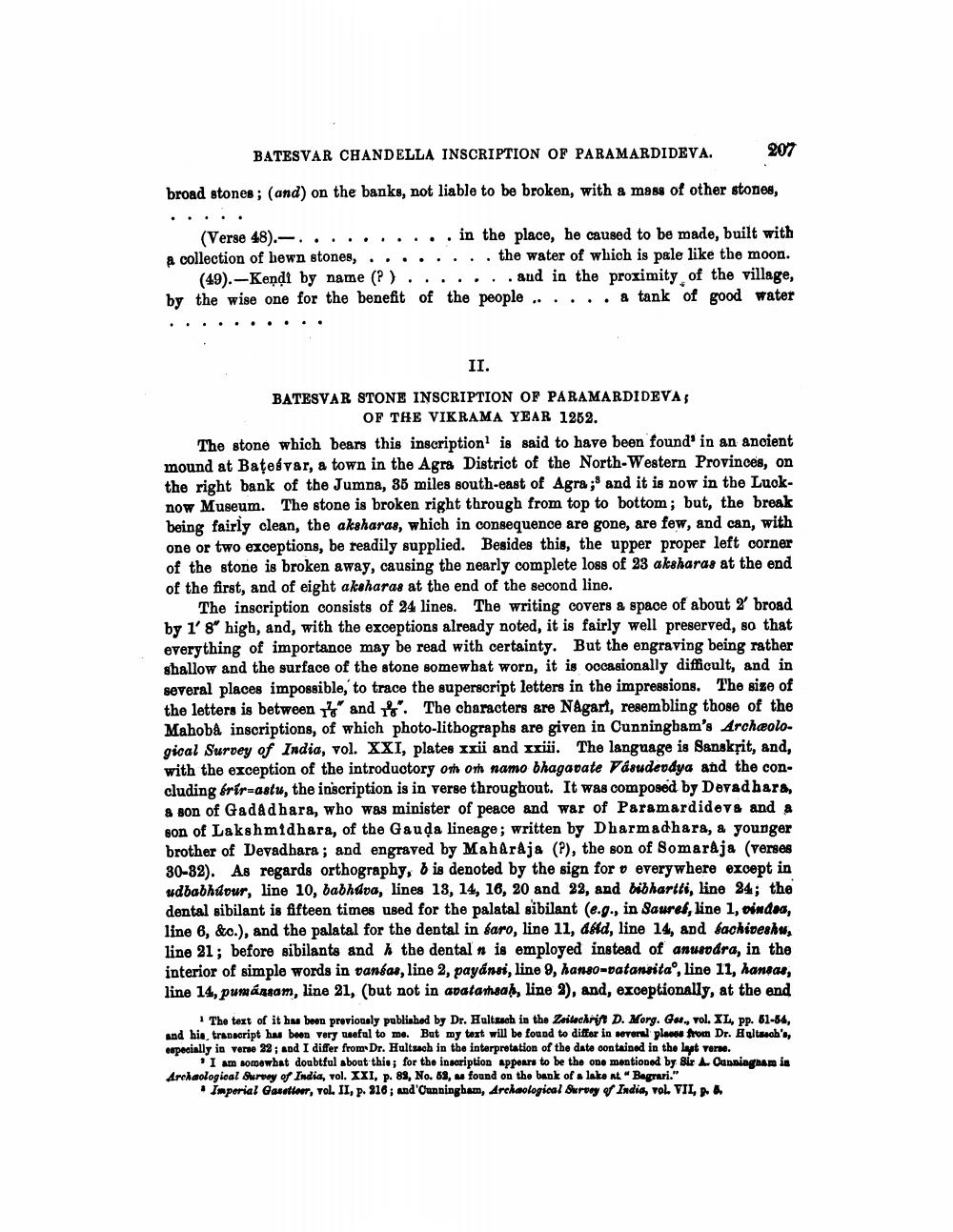________________
BATESVAR CHANDELLA INSCRIPTION OF PARAMARDIDEVA.
207
broad stones; (and) on the banks, not liable to be broken, with a mass of other stones,
(Verse 48).-.......... in the place, he caused to be made, built with a collection of hewn stones, ........ the water of which is pale like the moon.
(49).-Kendt by name (?)....... and in the proximity of the village, by the wise one for the benefit of the people ...... a tank of good water
II.
BATESVAR STONE INSCRIPTION OF PARAMARDIDEVAS
OF THE VIKRAMA YEAR 1252. The stone which bears this inscription' is said to have been found in an ancient mound at Batesvar, a town in the Agra District of the North-Western Provinces, on the right bank of the Jumna, 35 miles south-east of Agra;' and it is now in the Luoknow Museum. The stone is broken right through from top to bottom; but, the break being fairly clean, the aksharas, which in consequence are gone, are few, and can, with one or two exceptions, be readily supplied. Besides this, the upper proper left corner of the stone is broken away, causing the nearly complete loss of 23 aksharas at the end of the first, and of eight aksharas at the end of the second line.
The inscription consists of 24 lines. The writing covers a space of about 2 broad by 1' 8" high, and, with the exceptions already noted, it is fairly well preserved, so that everything of importance may be read with certainty. But the engraving being rather shallow and the surface of the stone somewhat worn, it is occasionally difficult, and in several places impossible, to trace the superscript letters in the impressions. The size of the letters is between 7" and ". The characters are Nagart, resembling those of the Mahoba inscriptions, of which photo-lithographs are given in Cunningham's Archeological Survey of India, vol. XXI, plates xxi and xxü. The language is Sanskrit, and, with the exception of the introductory on om namo bhagavate Vasudevdya and the concluding brir-astu, the inscription is in verse throughout. It was composed by Davadhara, & son of Gadadhara, who was minister of peace and war of Paramardiders and a son of Lakshmidhara, of the Gauda lineage; written by Dharmadhara, a younger brother of Deyadhara ; and engraved by Maharaja (?), the son of Somaraja (verses 30-82). As regards orthography, bis denoted by the sign for o everywhere except in udbabhiour, line 10, babhdva, lines 13, 14, 16, 20 and 22, and bibhartti, line 84; the dental sibilant is fifteen times used for the palatal sibilant (e.g., in Saurel, line 1, cindea, line 6, &c.), and the palatal for the dental in saro, line 11, 44d, line 14, and Sachidesku, line 21; before sibilants and the dental - is employed instead of anusodra, in the interior of simple words in vanéas, line 2, payánsi, line 9, hanso-patanaita", line 11, hansas, line 14, pumázsam, line 21, (but not in avatansah, line 3), and, exceptionally, at the end
The text of it has been proviously published by Dr. Hultsach in the Zeitechrift D. Morg. Gar., vol. XL, pp. 61-64, and hia, transcript has been very useful to me. But my text will be found to differ in several places from Dr. Aultseoh's, especially in verse 22; And I differ from Dr. Hultsach in the interpretation of the date contained in the lyt verne.
I am somewhat doubtful about this; for the inscription appears to be the one mentioned by Sir A. Ounningham ia Archaological Survey of India, vol. XXI, p. 88, No. 59, found on the bank of lake nt "Bagrari."
• Imperial Gasettor, vol. II, p. 916, and 'Cunningham, Archaological Survey of India, Vol. VII. &




